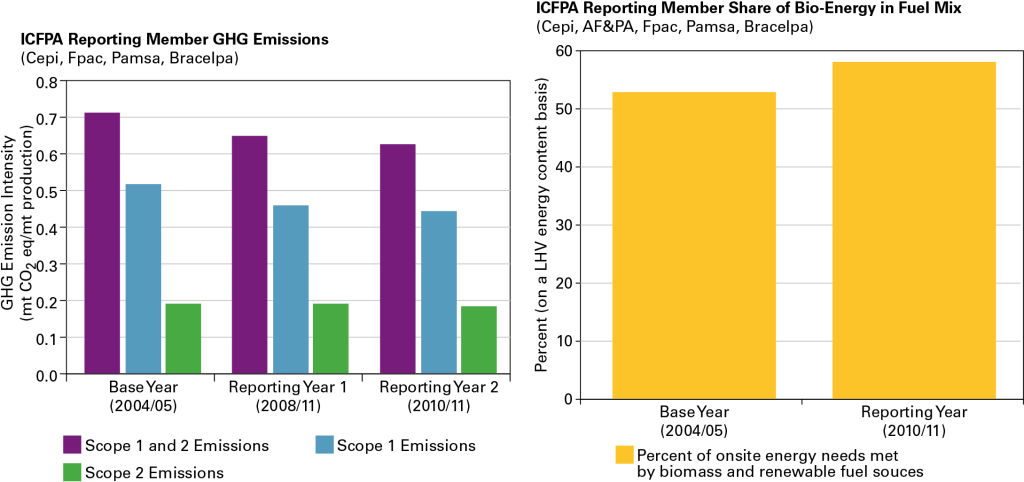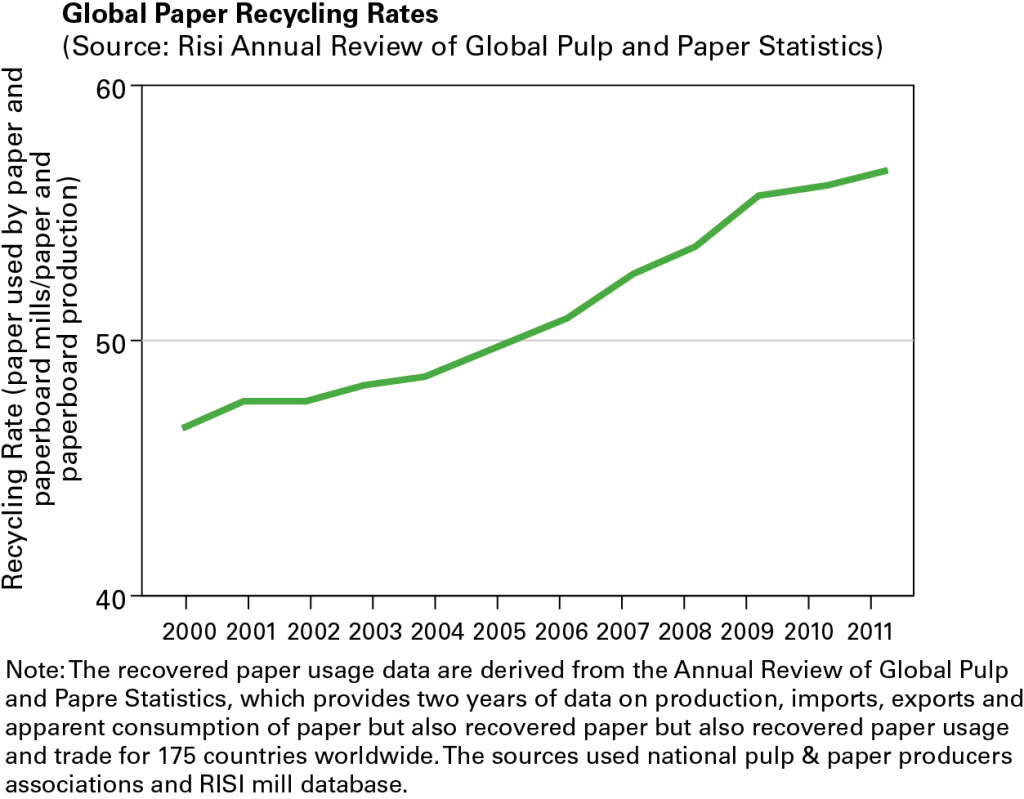Greenhouse gas emissions reduced by 16%, share of bio energy in the mix of fuels increased by 58%; also the number of certified hectares and the overall rate of paper recycling have increased, while SO2 emissions have reduced. These are the data from 2013 Sustainability Progress Report published by the International Council of Forest and Paper Association (ICFPA) who see an increasingly green sector.
The International Council of Forest and Paper Association (ICFPA) published its 2013 Sustainability Progress Report which shows improvements on a number of sustainability indicators and focuses on the contributions of a sector that moves more and more towards green economy. Its members, who are 38 forest and paper associations from 36 countries, have strong and clear commitments for sustainable development, demonstrating willingness to work with other entities interested in ensuring that environmental, social and economic benefits as well as forest resources are available for current and future generations. Since historical CEO Leadership Statement on Sustainability of 2006, ICFPA has been publishing a biannual report on progress and performance of its members in areas such as climate change, sustainable forest management, fight against illegal logging, and investments in people and communities. And this year it shows how the forest and paper industry support green economy through five key areas: resource efficiency, organic products, innovative technologies, Carbon Capture and Storage, and improved well-being of communities. A sort of forum for a global dialogue, a true connective tissue for the coordination and cooperation between forest and paper associations.

«Our industry is different in contributing to the economic development and social well-being of communities across the globe» said Donna Harman, president and CEO at the American Forest & Paper Association and president at ICFPA. «Our global industry is working every day to improve our practices and ensure that we deliver sustainably-produced, renewable, natural products to our domestic and global customers. We are proud of our accomplishments and we look forward to future progress as we contribute to sustainable development through new products and services in a green economy».
Sustainability indicators
1. Greenhouse gas emissions intensity has been reduced by 16 percent between 2005 and 2011.
2. The share of bio-energy in the industry’s fuel mix has increased by 5 percentage points since 2005 to 58 percent.
3. The number of hectares certified to a third-party sustainable forest management certification system increased by 38 percentage points since 2000 to 50 percent of wood supply.
4. Global paper recycling rates have increased by 10 percentage points between 2001 and 2011 to 56 percent.
5. Sulfur dioxide (SO2) emissions decreased by 34 percent between 2005 and 2011.
Better sustainability
What resulted from the Icfpa report shows global improvements in the field of sustainability: a contribution that comes from associations from Australia, Brazil, Canada, Chile, China, Europe, India, Japan, Lebanon, Malaysia, New Zealand, Russia, South Africa, and United States: «The 2013 Sustainability Progress Report shows global improvements on a range of sustainability indicators: greenhouse gas emissions have been reduced; the share of bio-energy in the industry’s fuel mix has increased; the number of hectares certified to a third-party sustainable forest management certification system has increased; global paper recycling rates have increased; and sulfur dioxide (SO2) emissions have decreased, «states Donna Harman, and she adds:» There are a number of exciting developments from countries around the globe. The 2013 Sustainability Progress Report provided examples of how the forest and paper industry is supporting a green economy through five key areas: resource efficiency, bio-based products, innovative technologies, carbon capture, and improved well-being of communities.»

The first time for China, India and Malaysia
A work that improves and strengthens with the involvement of an increasing number of countries: «We would like for more associations to participate in the future reporting process, so that more recognition can be given to the global industry’s progress. China, India and Malaysia, for example, were first-time members reporting for the 2013 Sustainability Progress Report” states Hartman, “we hope to continue this positive trend”. Countries with mutual projects in the sustainability field: «ICFPA has a number of policy statements agreed upon by its members. They are regularly reviewed and available on the ICFPA Website: many of these joint statements relate to issues of sustainability for which ICFPA members have consistent policies and extensive programs in support of the policies».

The role of Sustainability Reporting Working Group
In order to coordinate a work involving many «actors», there is a Sustainability Reporting Working Group made of six associations (AF & PA, Bracelpa, Cepi, Fpac, JPA and Pamsa) that have specific skills: «Most of the associations in the Sustainability Reporting Working Group are the original founding associations of the ICFPA. They are some of the largest associations in the Council, which means that they are able to provide the support, staff time and guidance needed to complete the Sustainability Progress Report. Each association also has well-developed system for collecting environmental performance data for their respective industries. The Sustainability Reporting Working Group’s meetings are dependent on the timing of the report, when preparing the report, they have regular conference calls. They also are responsible for outreach and collection of information from their regions of the world.»

The key points of the Sixth biennial international CEOs Roundtable
In June took plasce, in São Paulo (Brazil), the sixth biennial international Roundtable CEOs where more than 50 CEOs and association leaders from around the world met to address issues of common interest, including the consequences of economic pressures on forests from the demand for food, fuel and fiber, the impacts of government policies and programs on the forest products industry, and how to position the industry in its transition for the future. Interests which outweigh the differences, despite the high number of associations from different origins: «Global government policies have a large impact on the forest products industry’s operations and markets. There is strong agreement in the international community related to the positive role of forests, forest products and the related renewable energy produced in our manufacturing facilities in combatting climate change».
Let’s take a look at the items we dealt with and the tools to achieve the goals: «CEOs and association leaders discussed the need for greater forest productivity to meet future population needs for food, fuel, fiber and innovative products – including cosmetic, pharmaceutical, bioenergy, biotextiles and others. Forest biotechnology is one of many tools, but it faces social and political hurdles for acceptance in some parts of the world.Improving the quantity and quality of recycled fiber, particularly in emerging countries, is another important way to increase the fiber supply along with traditional methods in the forest.»
Summary of progress on global sustainability indicators
| Relevant Commitment | Global Indicator | Metric | Baseline Year | Reporting Year | Change |
| Creating solutions to globalclimate change and energysupply challenges | GHG Intensity | mt CO2eq/mt production(Scope 1 + 2 combined) | 0.72004/05 | 0.62010/11 | -16% |
| Share of Bio-Energyin Fuel Mix(NEW in 2013 )
|
% of onsite energy needsmet by biomass and renewablefuel sources
|
53%2004/05 | 58%2010/11 | +5 percentage points | |
| Promoting sustainable forestmanagement worldwide | SFM CertifiedHectares | % SFM certified hectares | 12%2000 | 50%2011 | +38percentage points |
| Fibre use and recovery | Global Recycling Rates | % of recovered paper usedby paper and paperboardmills from total paper and
paperboard production
|
46%2000 | 56%2011 | +10percentage points |
| Environmental management | SO2 Emissions(NEW in 2013) | kg SO2/mt production | 2.02004/05/06 | 1.32010/2011 | -34% |
The future belongs to everyone
Finally, participants discussed positioning the global forest products industry for the future. «Our industry needs to better communicate its strengths as an industry based on a renewable and sustainably managed forest resource that is evolving by producing new, value-added products in addition to traditional wood, paper and packaging products. The transformation of the industry is expected to improve the image of the industry, add value to products, and ensure that the industry attracts talented workers and managers in the future». And the future projects? «The ICFPA Steering Committee will have meetings to discuss the recommendations from the Roundtable CEOs. In addition, we have task forces that will be working on climate change policies, forest plantation policies and industry communications. And we will publish the next Sustainability Report in ICFPA 2015».
Icfpa members
| Country/Region | Association | Acronym |
| Australia | Australian Forest Products Association(1) | Afpa |
| Brazil | Brazilian Pulp and Paper Association | Bracelpa |
| Canada | Forest Products Association of Canada | Fpac |
| Chile | Corporación Chilena de la Madera | Corma |
| China | China Paper Association | Cpa |
| Europe | Confederation of European Paper Industries(2) | Cepi |
| India | Indian Paper Manufacturers Association | Ipma |
| Japan | Japan Paper Association | Jpa |
| Lebanon | Syndicate of the Owners of Paper and Packaging Industries in Lebanon | Sopil |
| Malaysia | Malaysia Pulp and Paper Manufacturers Association | Mppma |
| New Zealand | New Zealand Forest Owners’ Association | Nzfoa |
| Russia | The Russian Association ofPulp & Paper Organizationsand Enterprises
|
RaoBumprom |
| South Africa | Paper ManufacturersAssociation of South Africa | Pamsa |
| United States | American Forest & PaperAssociation | AF&PA |
(1) In 2011, the National Association of Forest Industries and the Australian Plantation Products and Paper Industry Council (A3P) merged to form the Australian Forest Products Association (AFPA).
(2) Representing 18 National Pulp and Paper Associations from the following countries: Austria, Belgium, Czech Republic, Finland, France, Germany, Hungary, Italy, Netherlands, Norway, Poland, Portugal, Romania, Slovak Republic, Slovenia, Spain, Sweden, United Kingdom.
